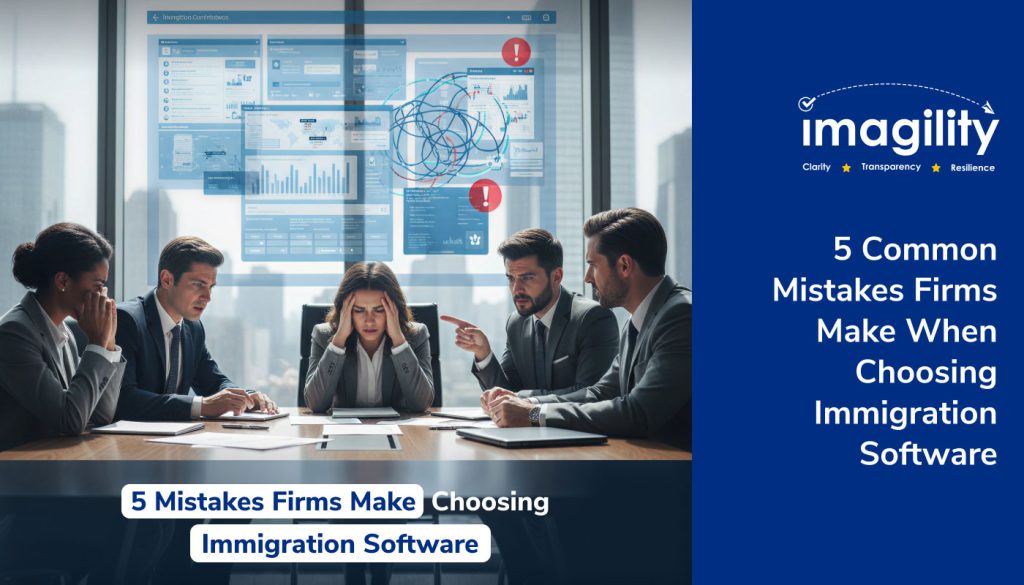Selecting the right immigration software is a strategic decision that can define a law firm’s efficiency and compliance success. The right platform can help you stay compliant, improve accuracy, and deliver faster results for clients. But the wrong choice can lead to compliance gaps, workflow inefficiencies, and costly vendor dependencies.
Many law firms rush the selection process, focusing only on basic features like form automation or document storage. Whereas, immigration practice management requires robust compliance tools, case automation, case tracking, data control, training support, and reliable performance during peak filing season.
Here are five common mistakes immigration law firms make when choosing software and how to avoid them.
1. Overlooking Compliance Capabilities
Mistake: Many firms focus on automation, document management, or client portals but overlook compliance, one of the most key elements.
Why It Matters: Immigration law is complex and constantly evolving. Without built-in compliance tools, even the most advanced immigration case management software can leave your firm exposed to regulatory risks. Missing or outdated forms, incomplete Public Access Files (PAFs), or I-9 errors can lead to DOL or ICE audits, monetary penalties, and loss of client trust.
Firms often underestimate the extent to which compliance automation can protect them. Features like real-time audit trails, document expiry alerts, LCA tracking, and automatic form updates not only simplify daily operations but also ensure your firm remains inspection-ready at all times.
What to Do: Choose a platform that offers comprehensive compliance coverage across the entire immigration lifecycle, from petition preparation to ongoing employer obligations. The best software for immigration law firms should automatically update USCIS and DOL forms, maintain historical audit records, and provide ready-to-download compliance reports that meet federal inspection standards.
2. Ignoring Data Portability and Vendor Lock-In
Mistake: Failing to ask whether your law firm’s data can be easily exported, integrated, or migrated to other systems.
Why It Matters: Immigration practices deal with sensitive client data such as forms, supporting evidence, case notes, and personal details. If your immigration software restricts access to data or doesn’t support standard export formats, you risk being trapped in an expensive vendor relationship. This “vendor lock-in” can make system upgrades or migrations difficult, limit interoperability, and even raise concerns about data ownership.
Law firms that lack control over their data often face unnecessary downtime, loss of productivity, and additional costs when transitioning to new systems. In an era where data privacy and flexibility are essential, this is a risk no law firm should take.
3. Choosing Based on Price Instead of Long-Term Value
Mistake: Opting for the lowest-cost solution without considering long-term returns.
Why It Matters: While budget is important, focusing solely on price often means compromising on quality, compliance coverage, and scalability. Low-cost tools may lack essential features like I-9 tracking, PAF management, or high-volume case processing that can save your law firm significant time and reduce legal exposure. Over time, the hidden costs of inefficiency, errors, and missed deadlines far outweigh the short-term savings.
What to Do: Evaluate software as a long-term investment, not an expense. Consider the total cost of ownership, including onboarding, training, support, and compliance protection. The best software for immigration law firms will enhance accuracy, automate manual tasks, and help you maintain compliance driving measurable ROI and client satisfaction.
4. Underestimating Training and User Adoption
Mistake: Assuming attorneys, paralegals, and staff will automatically adapt to a new system without structured onboarding or guidance.
Why It Matters: Even the most powerful immigration case management software delivers little value if your team does not use it effectively. Law firms that skip proper training often face resistance from staff, resulting in poor adoption rates and continued reliance on manual processes. This not only diminishes efficiency but also prevents firms from realizing the software’s full potential, particularly its automation and compliance features.
The transition to new technology requires clear direction, change management, and ongoing support. Without these elements, firms risk a partial or failed implementation, leading to wasted investment and lost productivity.
What to Do: Select a vendor that offers comprehensive onboarding programs, training materials, and dedicated customer support. Look for a platform with a user-friendly interface and intuitive workflows designed for immigration law professionals. Internally, appoint a technology lead who can assist colleagues, share best practices, and ensure consistent software adoption.
5. Not Testing System Performance for Peak Filing Seasons
Mistake: Overlooking system scalability and load performance during busy periods like H-1B cap season or PERM filing spikes.
Why It Matters: A platform that performs well during routine operations may fail under high traffic. Outages or slow response times during crucial filing windows can disrupt workflows, delay submissions, and damage client confidence.
What to Do: Request vendors to provide system uptime records, stress test results, and service-level agreements (SLAs). Ask whether their infrastructure supports elastic scaling for peak volumes. The best software for immigration law firms should maintain consistent speed, reliability, and security even under heavy loads.
Final Thoughts
Choosing immigration software is not just about digital convenience. It’s about compliance, scalability, and trust. The best platforms go beyond automating forms and help your law firm stay ahead of regulatory changes, safeguard data, and deliver a seamless client experience.
Firms that take time to assess compliance capabilities, data portability, user adoption, and long-term value will make smarter technology choices. Avoiding these common mistakes ensures you select software that not only supports your workflow but strengthens your reputation and client relationships.
In today’s competitive environment, the best software for immigration law firms is the one that helps you practice more efficiently, serve clients more effectively, and stay fully compliant with evolving immigration regulations.
Vendor Evaluation Checklist
Before finalizing a vendor, consider the following:
- Does the software include I-9, LCA, and PAF compliance modules?
- Are USCIS and DOL forms automatically updated?
- Can data be exported in open formats (CSV, XML, JSON)?
- Does the system support API integrations?
- Is migration assistance available?
- What certifications does the vendor hold (SOC 2, ISO 27001, GDPR, CCPA)?
- Is the total cost of ownership transparent?
- Are training and onboarding support included?
- Can the platform handle high filing volumes without lag?
- Are service-level agreements (SLAs) and performance metrics documented?
Imagility: Built for Compliance, Performance, and Growth
For firms seeking a trusted, future-ready solution, Imagility offers an AI-powered immigration case management software platform designed specifically for U.S. immigration attorneys.
Imagility combines advanced case tracking with compliance-driven modules for I-9 verification, LCA automation, and Public Access File (PAF) management, all in one secure system. It provides real-time audit trails, automatic form updates, and inspection-ready reports ensuring you are always audit-compliant and client-ready.
The platform ensures full data portability and high-performance scalability, empowering firms to maintain control and confidence even during peak filing periods. The system is tested for performance, backed by guaranteed uptime, and supported by a responsive customer success team.
From solo practitioners to large immigration law firms, Imagility helps streamline workflows, improve compliance accuracy, and deliver faster, more transparent client experiences.
Discover why leading attorneys consider Imagility the best software for immigration law firms.
Request a free demo today.










